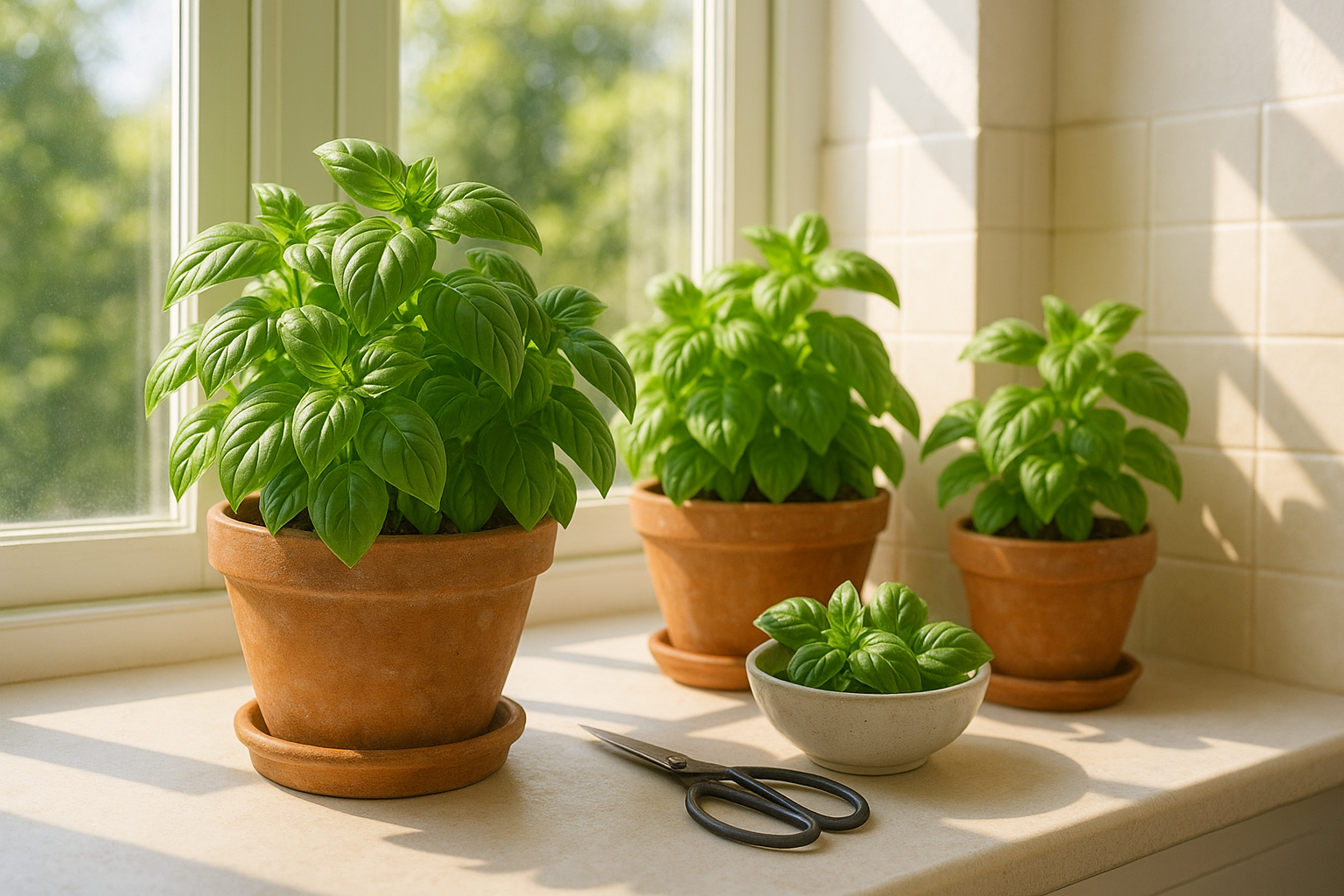Introduction
Organic basil growing has become a favorite pastime for home gardeners everywhere, and for good reason. Basil, with its fragrant green leaves and sweet, slightly spicy flavor, is a staple in kitchens around the world—whether you’re tossing it into a fresh Caprese salad, blending it into homemade pesto, or sprinkling it atop a pasta dish.
Beyond its culinary charm, basil is packed with nutrients such as vitamin K, manganese, and antioxidants that support everyday wellness. Choosing to grow organic basil at home gives you more than just tasty leaves whenever you need them—it also means you can skip the pesticides and enjoy a truly fresh harvest straight from your garden or windowsill.
Whether you’re looking to save money at the grocery store, steer clear of unwanted chemicals, or simply experience the joy of nurturing a plant from seed to kitchen table, organic basil growing offers a rewarding and surprisingly easy journey. In this guide, you’ll discover practical steps and real-life tips to help you succeed, whether you’re a complete beginner or a seasoned green thumb eager to add flavor and health to your homegrown meals.
Choosing the Right Basil Variety and Location
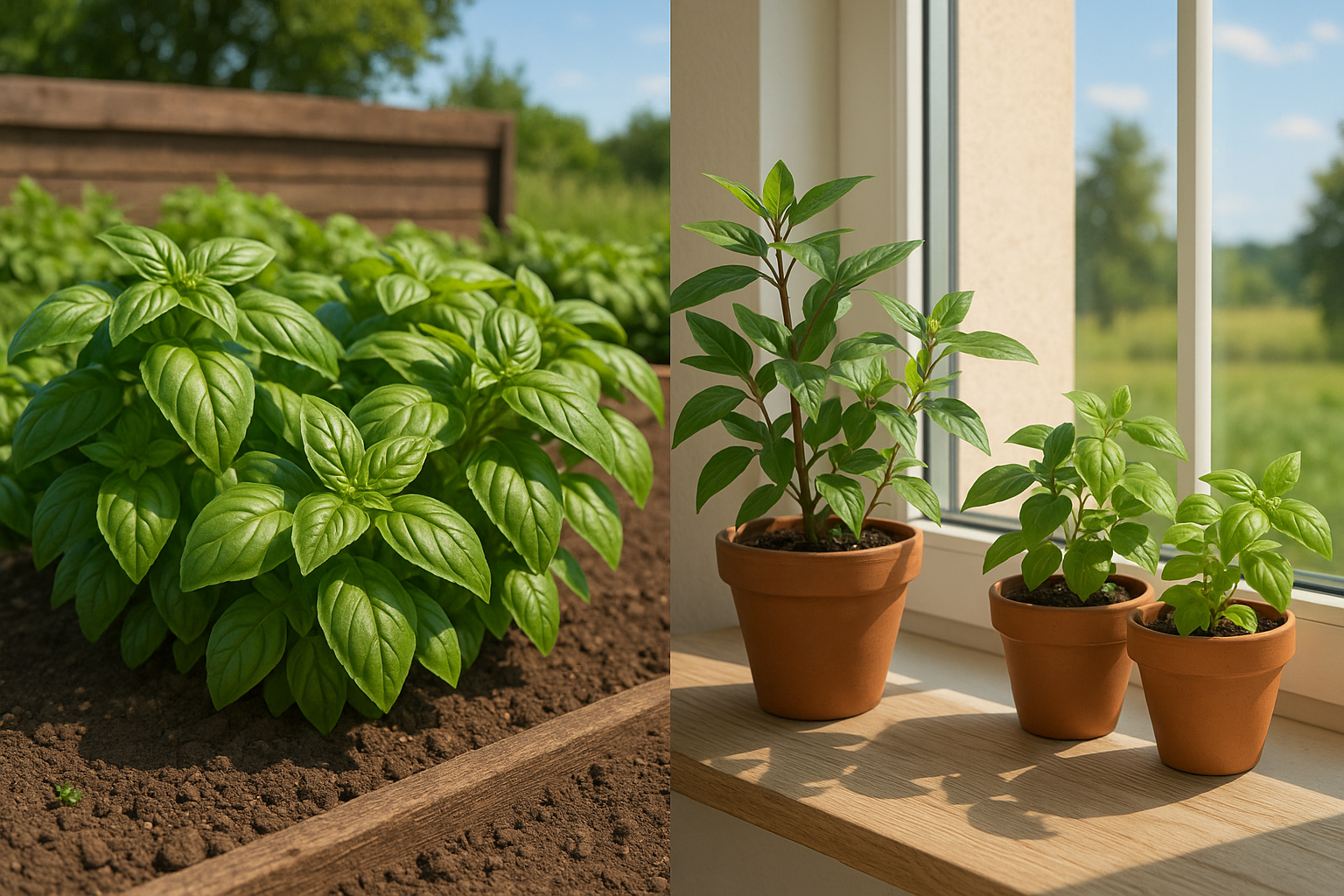
When it comes to growing basil, the variety you choose can make a big difference in both flavor and how well it adapts to your growing conditions. Genovese basil is a classic favorite, known for its sweet, slightly peppery notes and large, tender leaves—perfect for pesto or Caprese salads. Thai basil, on the other hand, brings a spicier kick with hints of anise and is a staple in Southeast Asian cuisine, thriving in warmer climates. Lemon basil, with its citrusy aroma, offers a fun twist for salads and teas, doing particularly well where summers are long and hot.
Your local climate should guide your choice: classic sweet and Genovese basils excel in mild, temperate regions, while Thai and lemon basil tolerate heat and humidity better. Whether indoors or outdoors, basil needs about six to eight hours of sunlight a day; a sunny windowsill or south-facing patio works wonders, but avoid cold drafts and nighttime temperatures below 50°F (10°C).
If you’re tight on space, a windowsill herb garden indoors can be just as productive as an outdoor plot—just be sure to rotate the pots for even light and keep the soil moist, but not soggy. For a truly flavorful and resilient plant, choose organic seeds or healthy, vibrant seedlings free from yellowing leaves or insect damage. Certified organic seeds ensure your basil is free from harmful chemicals right from the start, which benefits both you and your garden ecosystem.
Start fresh each year with new seeds—basil germinates quickly, and you’ll soon see shoots ready to flourish in your favorite dishes. With the right variety and growing spot, you’ll have lush basil at your fingertips all season long.
Preparing Soil and Planting Your Basil
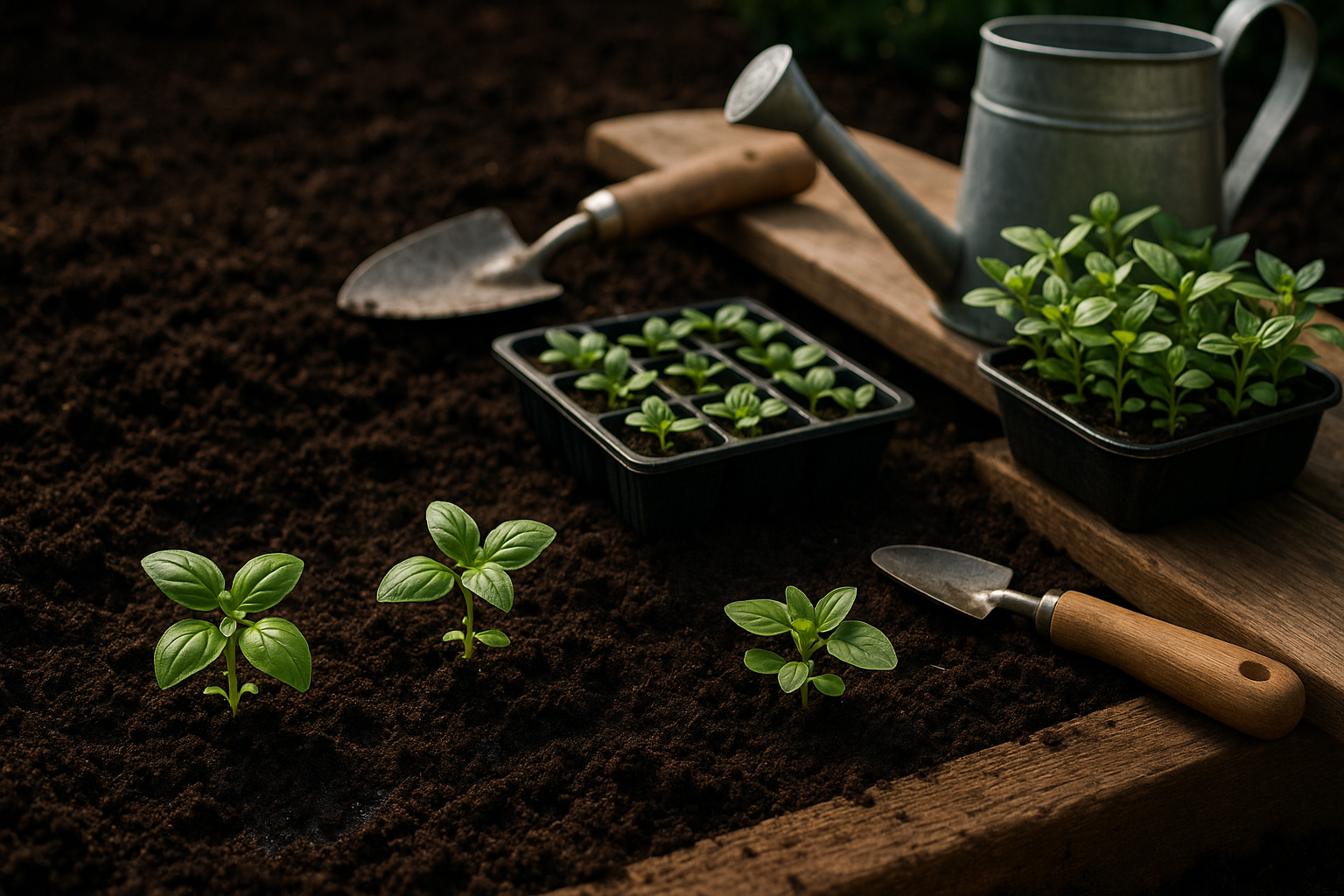
For vibrant, organic basil plants, start by preparing soil that’s loose, well-draining, and fertile—basil roots dislike soggy conditions, which can lead to root rot. Aim for rich loam with a slightly acidic to neutral pH (about 6.0 to 7.0). Mix in plenty of organic matter like well-rotted compost or aged manure; these amendments boost nutrients and improve moisture retention without waterlogging the soil.
If planting in the ground, check drainage by observing a rainstorm or running water through a test hole—if it sits for hours, amend the soil with sand or compost.
Starting from Seeds
For seeds, start indoors about 6–8 weeks before your region’s last expected frost. Fill seed trays with organic seed starting mix, sprinkle basil seeds on the surface, and lightly cover with 1/4 inch of soil. Keep trays warm (around 70°F/21°C) and moist, and expect sprouting within a week. When seedlings have two sets of true leaves, thin them to 2 inches apart.
Transplanting Seedlings
For transplants or seedlings, wait until all frost danger has passed and the soil feels warm to the touch—usually late spring. Dig small holes 8–12 inches apart, gently loosen each plant’s roots, and set them in the holes at the same depth as their pots. Water gently, then mulch lightly with straw or leaves.
Growing Basil in Containers
Growing basil in containers is ideal if you lack garden space or want to move plants indoors during cold snaps. Use pots at least 6 inches wide with drainage holes and high-quality, organic potting mix. Containers dry out faster and may require more frequent feeding, but ground planting offers more space and steadier moisture.
Regardless of your method, prioritize organic amendments and mindful watering for a steady supply of lush basil all season long.
Caring for Your Basil Plants
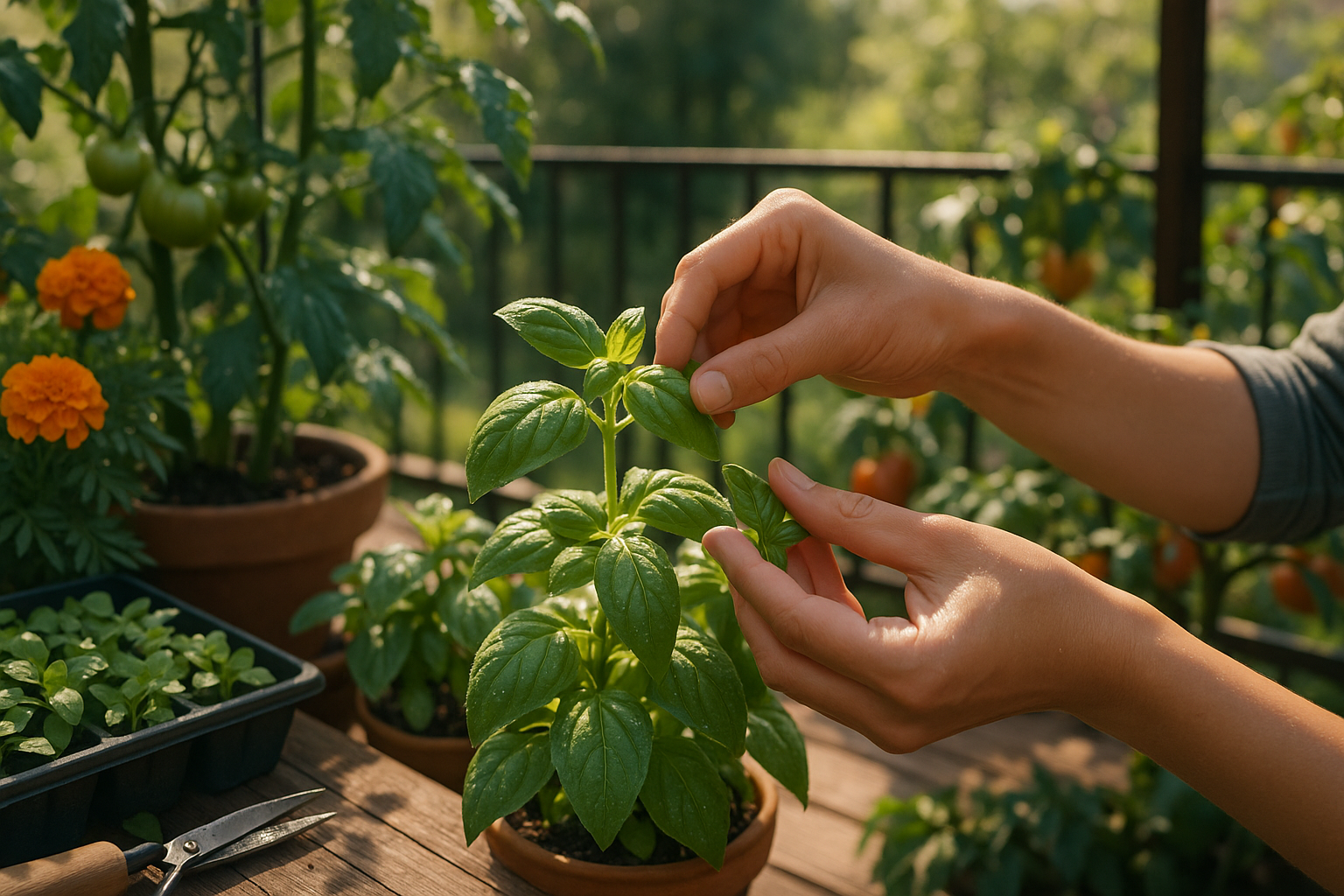
Taking care of basil organically is easy when you focus on the basics—right watering, natural fertilizing, gentle pruning, and simple protection.
Watering
Basil likes moist but not soggy soil. Water early in the morning so the leaves dry out as the sun rises, reducing fungal risks. One deep soak two to three times per week is better than light, frequent sprinkles. Always check the top inch of soil—if it’s dry, it’s time to water. Overwatering is a common mistake; yellow leaves and limp stems are warning signs to cut back.
Organic Fertilizing
Basil responds beautifully to compost tea—just steep finished compost in water for a day or two, then strain and water your basil with the liquid every two to four weeks. Avoid synthetic fertilizers, and don’t overdo manure, as excess nitrogen can make basil leafy but not flavorful.
Pruning and Pinching
Pruning and pinching help basil get dense and bushy. Once your plant has six to eight leaves, pinch off the very top set of leaves, just above a node (where leaves meet the stem). This encourages side shoots and prevents early flowering—remember, the more flowers, the less leaf growth. Repeat pinching every couple of weeks throughout the season.
Protection
Pests like aphids and Japanese beetles can bother basil, but a strong blast of water or hand-picking usually keeps problems at bay. Avoid chemical sprays—instead, companion planting with marigolds or basil’s favorite, tomatoes, can naturally repel pests. On blustery or scorching days, shield your basil with row covers or move potted plants to partial shade during the hottest hours.
With these organic practices, your basil stays lush, fragrant, and flavorful—ready for every summer salad or pesto craving.
Propagating Basil for Endless Supply
Propagating basil from cuttings is a simple, rewarding way to keep your kitchen stocked with fresh herbs all year round. Start by snipping a healthy, non-flowering stem just below a leaf node, then remove the lower leaves to expose about two inches of the stem.
For water propagation, place the cutting in a clear glass of fresh water—making sure no leaves are submerged—and watch roots appear within a week or two. Change the water every few days to prevent rot.
If soil propagation is your preference, plant the prepared cutting in moist, well-draining potting mix and keep it in a bright, indirect light spot. Covering it loosely with a plastic bag can boost humidity and help rooting.
Sometimes, leaves wilt or blacken during the process; this often means the cutting is too wet, the water hasn’t been changed, or the stem was injured during cutting. Always use clean scissors and sterile containers to avoid these issues.
Once you see robust roots, plant cuttings into pots or your garden and water well to reduce transplant shock.
Maintaining a Continuous Basil Supply
To keep a steady supply of basil, use succession planting: every two to three weeks, start new seeds or root fresh cuttings. This way, a new generation is always ready to harvest as older plants slow down. Staggered sowing ensures no gaps in your basil production.
Regularly pinch off the tops of maturing plants to encourage bushy growth and delay flowering. Flowering reduces leaf flavor and signals the plant to stop producing new leaves.
By following these strategies, you can enjoy a never-ending bounty of fragrant basil—perfect for garnishing pizzas, mixing pesto, or just adding a fresh touch to your meals.
Managing Pests, Diseases, and Other Problems
Basil is a kitchen staple, but it can quickly come under siege from pests and problems if you’re not vigilant. Common basil pests include aphids, spider mites, and whiteflies—tiny, sap-sucking insects that leave sticky residue or discolored, curling leaves behind. The best organic approach is to regularly inspect your plants and wash off these insects with a strong blast of water.
Introducing beneficial insects like ladybugs or lacewings can also help keep pest populations in check. For more stubborn infestations, try neem oil or insecticidal soap, always following the label instructions.
Fungal diseases, such as downy mildew and Fusarium wilt, are also common troubles. Watch out for symptoms like yellowing, wilting, or brown spots on leaves. Prevent these diseases by providing good air circulation: space your plants well, prune regularly, and water at the base rather than overhead to keep foliage dry. Mulching can help reduce splash-borne spores from the soil.
If you spot infected leaves, remove and discard them immediately—don’t compost!
Environmental stress can also trigger issues that mimic pest or disease symptoms. Yellowing leaves or wilting may signal too much sun, inconsistent watering, or poor drainage. Remedy these problems by ensuring your basil receives about six hours of gentle sunlight each day and that your containers or soil beds allow water to drain freely. Mulch helps retain moisture and shields roots from temperature swings.
If leaves are sunburned (look for dry, crispy brown patches), offer afternoon shade or move containers to a less harsh spot. Always let the top inch of soil dry out between waterings to prevent root rot.
By staying proactive and addressing issues early with these natural techniques, you can keep your basil healthy and thriving all season long.
Harvesting and Using Organic Basil
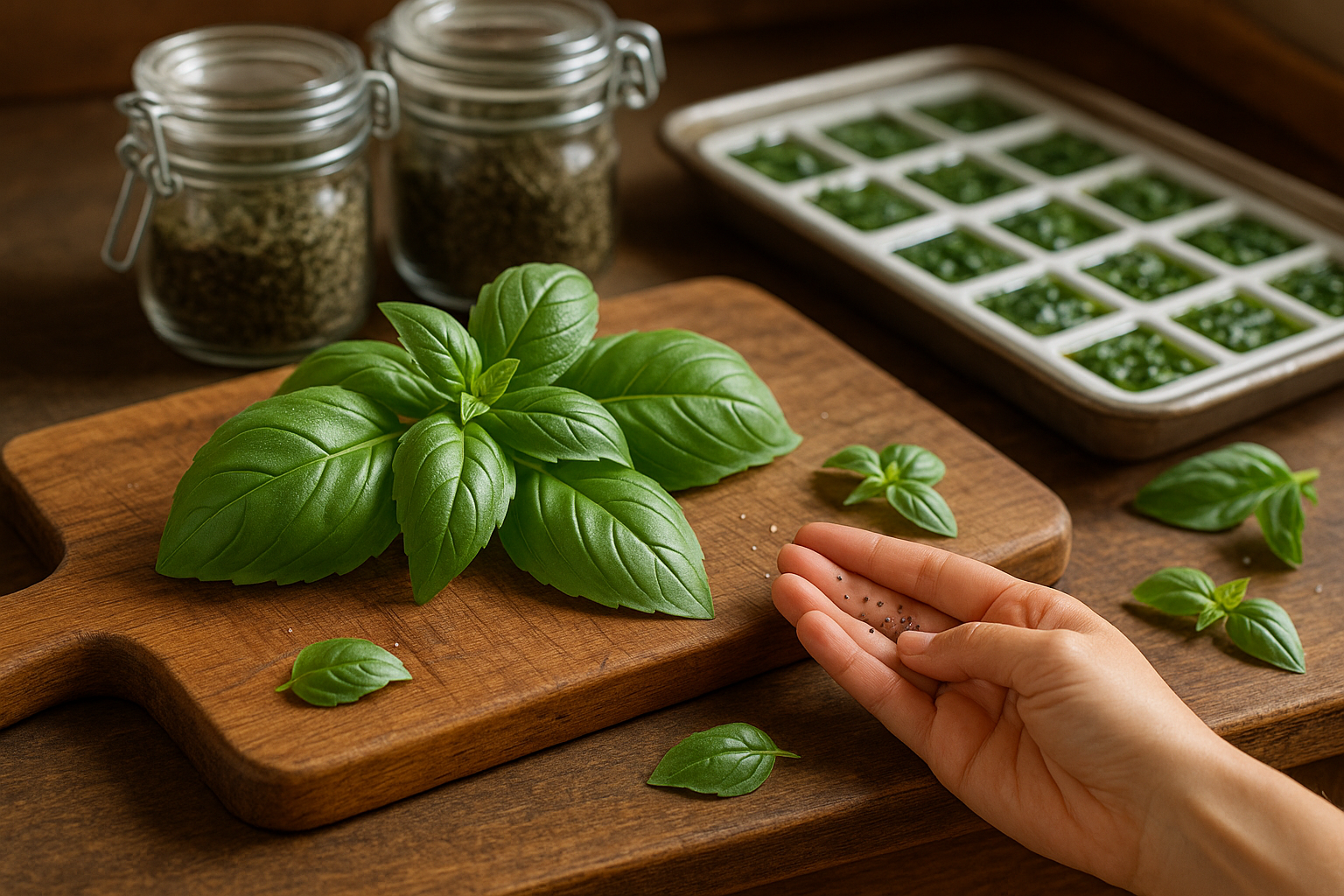
Harvesting organic basil at the right moment is key to getting the boldest flavor and encouraging your plants to produce more leaves throughout the season. For the best taste, pick basil just after the morning dew has dried, when the essential oils are most concentrated—usually before the plant flowers.
Always snip leaves or stems just above a set of two leaves or leaf nodes (the junction where two leaves emerge from the stem), using sharp, clean scissors or pruning shears. This strategic cut not only stimulates faster regrowth but also keeps the plant bushy and healthy. Never remove more than a third of the plant at once to avoid stressing it.
For ongoing productivity, get in the habit of pinching or trimming the top leaves every week or so, especially as soon as you spot any flower buds; removing these helps direct energy into more leaf growth.
Using Basil in the Kitchen and Preserving Your Harvest
In the kitchen, fresh basil leaves add an aromatic punch to salads, pasta sauces, pizzas, pesto, or even fruit salads. To preserve your harvest for later, wash and dry the leaves, then either:
- Freeze them whole in a single layer before transferring to freezer bags, or
- Chop and mix with olive oil, then spoon the mixture into ice cube trays to freeze in handy portions.
Drying is another option: tie small batches of basil stems and hang them upside down in a cool, dark, well-ventilated area, or use a dehydrator until the leaves are crumbly. Store dried basil in airtight containers away from light and heat to keep the flavor vibrant.
For both dried and frozen basil, labeling the containers with the harvest date will help you use your stash while it’s freshest and most flavorful.
Conclusion and Final Tips
Growing organic basil at home is surprisingly simple and incredibly rewarding—just a small space and a little care can yield lush, flavorful leaves for your kitchen. To keep your basil thriving, try rotating your pots every few days for even sunlight, and consider bringing your basil indoors during colder months to enjoy fresh herbs year-round.
For those eager to expand their herb garden, books like The Culinary Herbal or websites like the Herb Society of America offer plentiful tips and inspiration. With the right guidance, homegrown basil is just the beginning of your gardening journey.
